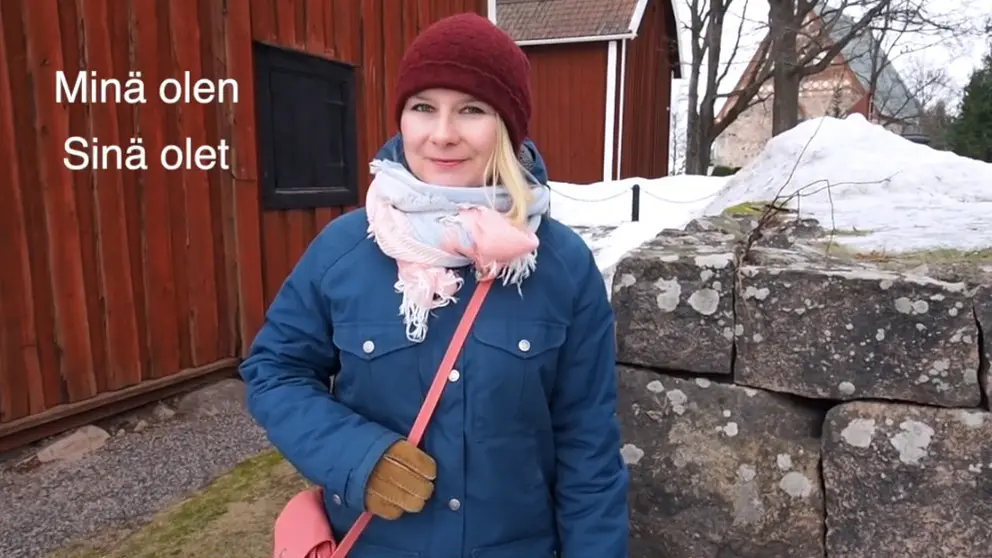There are six types of verbs in Finnish. They all are conjugated in a different way. Only few verbs are irregular - one of them is the most common verb, olla (to be). Let’s start with it:
Minä olen - I am
Sinä olet - You are
Hän on - S/he is
Me olemme - We are
Te olette - You are
He ovat - They are
Conjugation of verbs is based on two things: finding the stem of the verb and adding the personal endings. You can see the endings above in conjugated forms of the verb olla.
The personal ending for minä is letter -n, for sinä letter -t, for me letters -mme, for te letters -tte and for he letters -vat or -vät. For hän there is no specific ending, but the third person singular ends usually with two vowels (the verb olla is an exception).
Now let’s look at the verb types and learn how to find the stem.
Verb type 1
The first verb type is the most common. There are many often used verbs that belong to this group, for example puhua (to speak), katsoa (to look), sanoa (to say), kysyä (to ask). It is easy to recognise: the infinitive form ends always with two vowels.
You will get the stem by removing the last vowel from the infinitive form. For example the verb puhua: remove the last a and you will get the stem, puhu-. Now you can add the personal endings to the stem: minä puhun, sinä puhut, hän puhuu, me puhumme, te puhutte, he puhuvat.
Verb type 2
Verbs in the second verb type end with letters -da or -dä, for example syödä (to eat), juoda (to drink), myydä (to sell).
You will get the stem by removing the last syllable -da or -dä, for example myy-dä. Then you can add the personal endings: minä myyn, sinä myyt, hän myy (no extra vowels here, because the stem ends with two vowels), me myymme, te myytte, he myyvät.
Verb type 3
The infinitives in the third verb type end with two consonants and letter a or ä. The most common combination is -lla or -llä: opiskella (to study), kävellä (to walk), tulla (to come), kuunnella (to listen).
Other verbs in this group are for instance mennä (to go), purra (to bite), pestä (to wash).
You will find the stem by removing the last syllable and adding a letter e before the personal endings:
kävel-lä -> kävele- -> minä kävelen, sinä kävelet, hän kävelee, me kävelemme, te kävelette, he kävelevät.
Verb type 4
You will recognize the fourth verb type from the syllable -ta or -tä in the end of the infinitive form, for example pelata (to play), avata (to open), haluta (to want).
The stem is found by removing the letter t from the last syllable. The stem ends always with two vowels: pelata -> pelaa-. Then add the personal endings: minä pelaan, sinä pelaat, hän pelaa, me pelaamme, te pelaatte, he pelaavat .
Verb type 5
Also the fifth group ends with -ta or -tä, but there is a letter i before the last syllable. For example valita (to choose), häiritä (to disturb), tarvita (to need).
In order to get the stem, you have to remove the last syllable and add letters -tse- before the personal endings. For example, valita -> vali + tse -> minä valitsen, sinä valitset, hän valitsee, me valitsemme, te valitsette, he valitsevat.
Verb type 6
The last verb type ends with letters -eta or -etä, for example vanheta (to become older).
You will get the stem by removing the last syllable -ta (or -tä) and adding letters -ne- before the personal endings: vanheta -> vanhe + ne -> minä vanhenen, sinä vanhenet, hän vanhenee, me vanhenemme, te vanhenette, he vanhenevat.
Congratulations, you made it! Now you know all the Finnish verb types!
There is a lot of information in this lesson. I suggest you take your time to familiarise with the verb types and finding the stems. If the verb types are new to you, it may be better to learn them one at a time. They are after all very logical, keep on studying!
If you prefer learning with videos, you will find my introduction video as well as separate videos of all the the verb types here:
Nähdään ensi viikolla!










